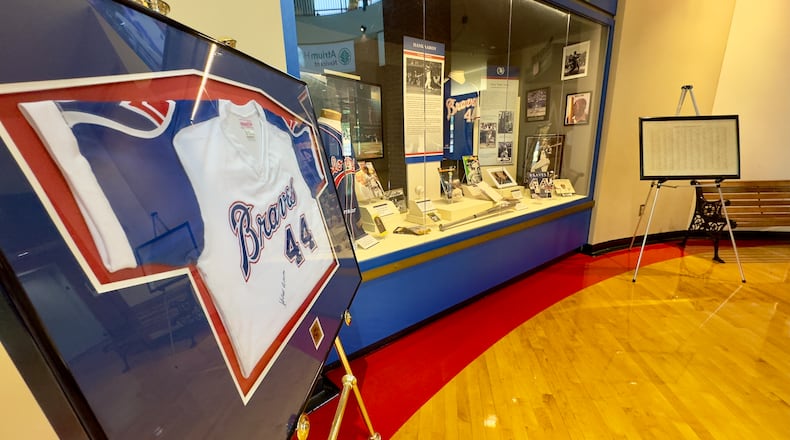MACON — On a hot spring evening at Luther Williams Field in 1953, a teenage Henry Aaron cracked a 355-foot home run for the minor league Jacksonville Braves in a win over the Macon Peaches.
It had been 95 degrees on that next-to-last Friday in May, but the swelter did not deter 2,481 spectators in attendance, 1,008 of whom were Black. In segregated seating beyond an outfield wall, many of them were there to see the visiting Braves, one of the first integrated teams in the South Atlantic League, and Aaron, their budding superstar.
“A large contingent of colored fans ... overflowed in the bleachers back of the left field fence,” a local sportswriter’s dispatch noted. “The (Braves’) three Negro players, Felix Mantilla, Henry Aaron and Horace Garner, gave them plenty to yell about. The white fans pulled for the Peaches all the way through, even when they were eight runs behind.”
Aaron’s home run that night and another the next were among the first long balls the 19-year-old Mobile, Ala., native deposited onto Georgia soil. The next season, he would join the Braves’ major league squad in Milwaukee.
A decade later, after the franchise moved to Georgia for the 1966 season, Hammerin’ Hank slugged 192 homers in games played at Atlanta-Fulton County Stadium. It was a monumental home run that the baseball and civil rights hero socked there on the night of April 8, 1974 that would be most remembered.
Now, in something of a full-circle moment, that homer, the 715th of his big-league career, which eclipsed Babe Ruth’s hallowed mark as baseball’s grandest feat, is being lauded back in Macon.
The Georgia Sports Hall of Fame — standing barely two-thirds of a mile from home plate in the ancient ballpark where Aaron launched his home runs in this city — is featuring an exhibit through July saluting the 50th anniversary of his record-breaking big-league blast.
Joe Kovac Jr.
Joe Kovac Jr.
“It’s unreal what he accomplished,” the hall’s executive director Jim McClendon says.
In April, the Atlanta History Center unveiled an exhibit of its own, an homage to Aaron that includes memorabilia and other items of historical significance. In a similar vein, on display at the sports hall in Macon are Aaron jerseys, including a replica of one he wore while playing for the Indianapolis Clowns.
There is a commemorative bat and an issue of Sports Illustrated with a photo of Aaron on the front holding up his famous homer. The magazine cover’s lone headline: “715.” Also encased in the exhibit are autographed cards and an unusual relic, an original copy of a vinyl 45 record that was released during Aaron’s pursuit of Ruth, with a song titled “Move Over Babe (Here Comes Henry).”
Last weekend in Macon, some older visitors at a celebration of the Aaron exhibit that the sports hall hosted could not believe how much time had passed since Aaron bested the Babe. The hall’s McClendon says, “I heard people looking at this exhibit and saying, ‘Fifty years ago?’”
Nathan Jones, curator at the Middle Georgia hall, has noticed that many who come to see the display he created were either very young or not born when Aaron’s playing career ended in 1976. Jones often asks children who visit if they’ve heard of Aaron.
“Almost all of them will say, ‘No,’ that they’ve never heard of him or any mention of him,” Jones says. “But if I mention the Braves in general, a lot of them will say, ‘Yeah.’ So I’ll kind of bridge that and tell them about Hank and what he means. Hank’s a really good link to the past.”
There is a framed poster on an easel flanking the main exhibit.
The poster is a 2-foot-wide listing of Aaron’s home runs leading up to No. 715. The tiny print squeezed onto the poster reads like an old newspaper’s stock market report, an exhaustive menu of all the pitches Aaron feasted on.
“You show that to a kid and tell them, ‘Those are all home runs,’” Jones says. “They’re like, ‘Whaaaat?’”
Joe Kovac Jr.
Joe Kovac Jr.
About the Author








